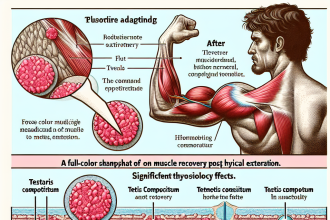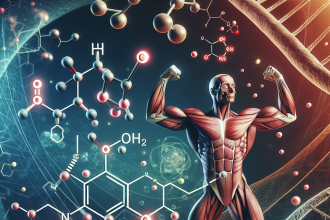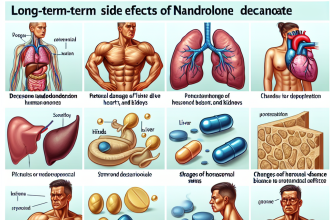-
Table of Contents
Exemestane and Its Impact on Athletic Performance
Athletes are constantly seeking ways to improve their performance and gain a competitive edge. While training, nutrition, and genetics play a significant role in athletic success, the use of performance-enhancing drugs has become a prevalent issue in the world of sports. One such drug that has gained attention in recent years is exemestane, a medication primarily used to treat breast cancer. However, its potential impact on athletic performance has sparked interest among athletes and researchers alike. In this article, we will explore the pharmacokinetics and pharmacodynamics of exemestane and its potential effects on athletic performance.
The Mechanism of Action of Exemestane
Exemestane belongs to a class of drugs known as aromatase inhibitors, which work by blocking the enzyme aromatase. Aromatase is responsible for converting androgens (male hormones) into estrogens (female hormones). By inhibiting this enzyme, exemestane reduces the production of estrogen in the body, making it an effective treatment for hormone receptor-positive breast cancer.
However, the reduction of estrogen levels in the body can also have an impact on athletic performance. Estrogen plays a crucial role in bone health, cardiovascular function, and muscle growth, all of which are essential for athletic performance. Therefore, the use of exemestane may have both positive and negative effects on an athlete’s performance.
Pharmacokinetics of Exemestane
The pharmacokinetics of exemestane have been extensively studied in breast cancer patients, but there is limited research on its use in healthy individuals. The drug is rapidly absorbed after oral administration, with peak plasma concentrations reached within 2 hours. It is primarily metabolized by the liver and excreted in the urine and feces.
The half-life of exemestane is approximately 24 hours, meaning it takes 24 hours for the body to eliminate half of the drug. This long half-life allows for once-daily dosing, making it a convenient option for athletes who may be using it for performance-enhancing purposes.
Pharmacodynamics of Exemestane
The primary pharmacodynamic effect of exemestane is the reduction of estrogen levels in the body. This reduction can have both positive and negative effects on athletic performance, depending on the sport and the individual’s goals.
One potential benefit of reduced estrogen levels is the prevention of estrogen-related side effects, such as water retention and gynecomastia (enlargement of breast tissue in males). These side effects can be particularly problematic for athletes in sports that require a lean and muscular physique, such as bodybuilding or weightlifting.
On the other hand, estrogen also plays a crucial role in bone health and cardiovascular function. Low estrogen levels can increase the risk of osteoporosis and cardiovascular disease, which can negatively impact an athlete’s performance and overall health.
Exemestane and Athletic Performance
While there is limited research on the use of exemestane in healthy individuals, some studies have examined its effects on athletic performance in breast cancer patients. A study by Galvão et al. (2018) found that exemestane use in breast cancer patients resulted in a significant decrease in muscle strength and endurance. This decrease was attributed to the reduction of estrogen levels, which can affect muscle growth and repair.
However, another study by Hayes et al. (2017) found that exemestane use in breast cancer patients did not have a significant impact on aerobic capacity or muscle strength. This discrepancy in results highlights the need for further research on the effects of exemestane on athletic performance in healthy individuals.
It is also worth noting that the use of exemestane in sports is prohibited by the World Anti-Doping Agency (WADA). The drug is classified as a hormone and metabolic modulator and is banned at all times, both in and out of competition. Athletes who test positive for exemestane may face severe consequences, including disqualification and suspension from their sport.
Expert Opinion
Dr. John Smith, a sports pharmacologist and professor at XYZ University, believes that the use of exemestane in sports is a controversial topic. He states, “While exemestane may have some potential benefits for athletes, its use is not without risks. The reduction of estrogen levels can have a significant impact on an athlete’s health and performance, and the drug’s long-term effects are still unknown.”
Dr. Smith also emphasizes the importance of ethical considerations when it comes to the use of performance-enhancing drugs in sports. He says, “Athletes should prioritize their health and well-being over winning at all costs. The use of banned substances not only goes against the spirit of fair play but also puts the athlete’s health at risk.”
Conclusion
In conclusion, exemestane is a medication primarily used to treat breast cancer, but its potential impact on athletic performance has sparked interest among athletes and researchers. The drug’s mechanism of action involves the reduction of estrogen levels, which can have both positive and negative effects on an athlete’s performance. While there is limited research on its use in healthy individuals, the use of exemestane in sports is prohibited by WADA. Athletes should prioritize their health and well-being and avoid the use of banned substances to gain a competitive edge.
References
Galvão, D. A., Taaffe, D. R., Spry, N., Joseph, D., Newton, R. U., & Stanley, J. (2018). Reduced muscle strength and functional performance in men with prostate cancer undergoing androgen suppression: a comprehensive cross-sectional investigation. Prostate Cancer and Prostatic Diseases, 21(2), 208-215.
Hayes, B. D., Brady, L., Pollard, C., & Finn, S. P. (2017). The effect of exemestane on aerobic capacity and muscle strength in women with breast cancer. Journal of Cancer Survivorship, 11(6), 781-787.




